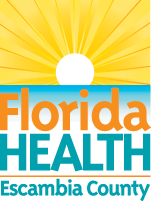It's a New Day in Public Health.
The Florida Department of Health works to protect, promote, and improve the health of all people in Florida through integrated state, county, and community efforts.
County Health Ranking Escambia
March 25, 2015
PENSACOLA, FL – The Florida Department of Health in Escambia County (FDOH-Escambia) recognizes the value in measuring health outcomes and health factors and acknowledges the sixth annual County Health Rankings & Roadmaps (CHRR) tool, released today by the University of Wisconsin (UW) and the Robert Wood Johnson Foundation (RWJF). Analysts at UW and RWJF evaluate data related to physical environments, social and economic factors, health behaviors, and clinical care. The CHRR highlights the many community factors that influence health and uses established data, much of which is available at the Florida Department of Health’s data website, www.floridacharts.com.
“Health impacts each resident of Escambia County, Florida, both on a personal level and as members of the community,” said Dr. John Lanza, director of FDOH-Escambia. “A very important point that we gather from the rankings tool is that promoting optimal health requires the engagement of all branches of our community including government, education, business and civic organizations.”
These rankings are a snapshot of the health of counties across the country and they emphasize that health is not a singular effort but a combined work in progress across all community partners. FDOH-Escambia works in collaboration with local governments, non-profit organizations, health care facilities, business groups, schools, faith-based organizations and many other stakeholders to improve the health of all people in Escambia County.
FDOH-Escambia participates, along with Baptist Health System, Escambia Community Clinics, Sacred Heart Health System, FDOH-Santa Rosa and many other area stakeholders in the Partnership for a Healthy Community (PFAHC). In 2013, PFAHC published the area’s current Community Health Improvement Plan (CHIP). A CHIP addresses specific opportunities for improved health that have been identified by that community. The PFAHC’s 2013 CHIP for our community addresses the need for improvement in the areas of nutrition and physical activity, tobacco use, and health access management. The CHIP is promoted to the community through the Live Well Northwest Florida (Live Well NWFL) initiative. FDOH-Escambia partners with many stakeholders to implement the CHIP and collaborates regularly to evaluate the plan.
According to PFAHC Board President Nora J. Bailey, “The Partnership for a Healthy Community looks forward to each year’s release of the County Health Rankings and Roadmaps tool. The mission of the Partnership for a Healthy Community is to periodically conduct comprehensive health status assessments and to advance, support and promote collaborative initiatives to improve health and quality of life for residents of Escambia County and Santa Rosa County in Northwest Florida. The rankings report gives us insight into how individual behaviors, clinical resources, social and economic factors, and the physical environment come together to impact health in our counties.”
The chairperson of PFAHC’s Healthy Weight Work Group and University of West Florida Associate Professor in Community Health Education Dr. Debra Vinci, RDN, agrees, “The rankings tool looks at many factors that correlate with weight and body mass index (BMI), including the food environment, physical inactivity and access to exercise opportunities. Higher BMIs within a population are associated with increased incidence of chronic diseases in that community, leading to poor quality of life, increased healthcare costs and premature death.”
Becky Washler, Sacred Heart Health System’s liaison to PFAHC, also finds the information compiled in the rankings tool helpful. “These rankings have now provided us with several years of consistent insight into the key factors and outcomes that impact our community’s health, particularly those outside of the traditional healthcare setting. The annual release of this type of data, for local communities nationwide, helps to broaden community awareness and understanding of the roles we all play. Furthermore, it generates the important conversations that lead to action and involvement in strategic initiatives, such as Live Well NWFL, to become a healthier community.”
“We always want to improve our health status, but that will not happen overnight,” said Dr. Lanza. “We need to remain united and focused on improving the factors that affect our community’s health. The changes that we make today will improve the lives and the health of our residents for generations to come.”
###
The Florida Department of Health works to protect, promote and improve the health of all people in Florida through integrated state, county and community efforts.
For more information about the Florida Department of Health please visit www.floridahealth.gov. Follow us on Twitter at @HealthyFla and on Facebook.For Media Inquiries
@HealthyEscambia
@HealthyFla





Connect with DOH